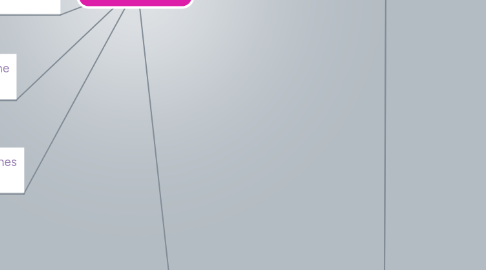
1. Reproduction
1.1. Lytic cycle
1.2. Lysogenic cycle
1.2.1. Becomes part of host's DNA
2. Biodiversity: Variety of life in the world
3. Genetic diversity: different genes are present in a species
4. Ecosystem diversity: range and variety of habitats with different organisms living in them.
5. Species diversity: Variety of species in a given area
6. Viruses
6.1. Contain DNA, protection protein coat
6.2. Tranmittions
6.2.1. Physical contact, coughing, sneezing, contaminated surfaces
6.3. Virons-abnormalities caused by abnormalities of host
7. Classifying Organisms
7.1. Taxonomy
7.1.1. Polynomial System
7.1.1.1. Genus name followed by description of organism
7.1.2. Common Classification System
7.1.2.1. Kingdom
7.1.2.2. Phylum
7.1.2.3. Class
7.1.2.4. Order
7.1.2.5. Family
7.1.2.6. Genus
7.1.2.7. Species
7.1.3. Binomial Nomenclature
7.1.3.1. Genus name followed by species. It also makes up the scientific name of organism
7.1.4. Family Name
7.1.4.1. Genus or Generic name
7.1.5. Personal Name
7.1.5.1. Specific name for organism
7.2. 3 Domains of Life
7.2.1. Bacteria
7.2.1.1. Prokaryotic organisms that are microscopic
7.2.2. Archae
7.2.2.1. Prokaryotic organism
7.2.3. Eukarya
7.2.3.1. Eukaryotic organism
7.3. The Six Kingdoms
7.3.1. Archae
7.3.1.1. Characteristics
7.3.1.1.1. Prokaryotic
7.3.1.1.2. Can survive in extreme environments
7.3.1.1.3. Genetically differs from Eubacteria
7.3.1.2. Types
7.3.1.2.1. Methanogens
7.3.1.2.2. Halophiles
7.3.1.2.3. Thermophiles
7.3.1.2.4. Psychrophiles
7.3.2. Eubacteria
7.3.2.1. Characteristics
7.3.2.1.1. Prokaryotic
7.3.2.1.2. Has ribosomes, flagella, pili, plasmids and cell walls that contain peptidoglycan and a capsule sometimes
7.3.2.1.3. Shape can be caucus, bacillus, spirilium
7.3.2.1.4. Can be grouped as diplococcic, streptococci and staphylococci.
7.3.2.2. Types
7.3.2.2.1. Pathogens
7.3.2.2.2. Mutualistic
7.3.2.2.3. Commercial
7.3.2.3. Composition
7.3.2.3.1. Gram Positive
7.3.2.3.2. Gram Negative
7.3.2.4. Metabolism
7.3.2.4.1. Autotrophic
7.3.2.4.2. Heterotrophic
7.3.2.4.3. Can be obligate aerobes, facultative anaerobes or obligate anaerobes.
7.3.2.5. Reproduction
7.3.2.5.1. Binary Fission
7.3.2.5.2. Conjunction
7.3.2.5.3. Transformation
7.3.2.5.4. Endospore formation
7.3.3. Protista
7.3.3.1. Characteristics
7.3.3.1.1. Heterotrophs
7.3.3.1.2. Autotrophs
7.3.3.1.3. Motile
7.3.3.1.4. First eukaryotes
7.3.3.2. Classification
7.3.3.2.1. Plant-like
7.3.3.2.2. Animal-like
7.3.3.2.3. Fungi-like
7.3.4. Fungi
7.3.4.1. Characteristics
7.3.4.1.1. Multi cellular
7.3.4.1.2. Are decomposers
7.3.4.1.3. Saltines
7.3.4.2. Classification
7.3.4.2.1. Classified by reproductive structures
7.3.4.3. Structures
7.3.4.3.1. Hyphae
7.3.4.3.2. Sporocap
7.3.4.3.3. Mycelium
7.3.4.4. Divisions
7.3.4.4.1. Cytridiomycota
7.3.4.4.2. Zygomycota
7.3.4.4.3. Ascomycota
7.3.4.4.4. Basidiomycota
7.3.5. Plantae
7.3.5.1. Characteristics
7.3.5.1.1. Eukaryotic
7.3.5.1.2. Multicellular
7.3.5.1.3. Undergo photosynthesis
7.3.5.1.4. Contain cellulose in cell wall
7.3.5.1.5. Develop embryos from tissue of plant
7.3.5.2. Vascular Plants
7.3.5.2.1. Have conducting tissue
7.3.5.2.2. can grow taller due to conducting tissue
7.3.5.2.3. 2 Main groups
7.3.5.3. Non-Vascular plants
7.3.5.3.1. Limit to size (max 20 cm)
7.3.5.3.2. Have no true roots, stems, leaves or specialized tissue
7.3.5.3.3. Grow on dense mats in moist conditions
7.3.5.3.4. Asexual and sexual reproduction
7.3.5.4. 5 Major Phyla
7.3.5.4.1. Green Algae
7.3.5.4.2. Bryophytes
7.3.5.4.3. Lycophytes / Pterophytes
7.3.5.4.4. Gymnosperms
7.3.5.4.5. Angiosprem
7.3.5.5. Life cycle: Alternation of generations
7.3.5.5.1. Gametophyte generation
7.3.5.5.2. Sporophyte generation
7.3.6. Animalia
7.3.6.1. Characteristics
7.3.6.1.1. Eukaryotic
7.3.6.1.2. Lacks cell wall
7.3.6.1.3. Multicellular
7.3.6.1.4. Heterotrophs
7.3.6.1.5. Motile
7.3.6.1.6. Blastula during embryological development
7.3.6.2. Vertebrates
7.3.6.2.1. Have backbone
7.3.6.3. Invertabrates
7.3.6.3.1. Lack backbone
7.3.6.4. Symmetry
7.3.6.4.1. Assymmetrical
7.3.6.4.2. Radial
7.3.6.4.3. Bilateral
7.3.6.5. Phylums
7.3.6.5.1. Porifera
7.3.6.5.2. Cnidaria
7.3.6.5.3. Annelida
7.3.6.5.4. Arthropoda
7.3.6.5.5. Mullusca
7.3.6.5.6. Platyheiminthes
7.3.6.5.7. Nemataods
7.3.6.5.8. Chordates
7.3.6.5.9. Echinodermata
7.3.6.6. Deuterosome
7.3.6.6.1. Anus develops first
7.3.6.6.2. If cell is removed at early development, it will not impact individual
7.3.6.7. Protosome
7.3.6.7.1. Mouth develops first
